Kids Guitars: Buying Your Child’s First Guitar | A Parents’ Guide
Author: Wanda Waterman

I bought my first guitar from a classmate in the first year of secondary school. It was an old barrel, but I didn’t see it that way back then. It was a ticket to another world.
~ guitarist, composer, and recording artist Jan Wouter Oostenrijk
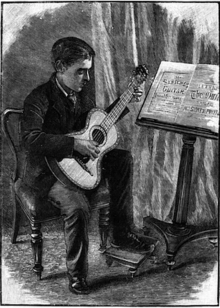 My first guitar was an acoustic that my dad and I picked out at a local music store in Palo Alto. We knew nothing about buying guitars and bought a used one with no name. I didn’t know it but the action was terrible— you could slice cheese through the strings! I’m so glad that I still loved that guitar and stuck with it.
My first guitar was an acoustic that my dad and I picked out at a local music store in Palo Alto. We knew nothing about buying guitars and bought a used one with no name. I didn’t know it but the action was terrible— you could slice cheese through the strings! I’m so glad that I still loved that guitar and stuck with it.
~guitarist, composer, producer, and recording artist Conrad Praetzel
She came to me despite my upbringing and taught me to speak without words.
~ singer, songwriter, and guitarist Andy Flinn (regarding his first guitar)
Table of Contents
So Your Child Wants a Guitar…
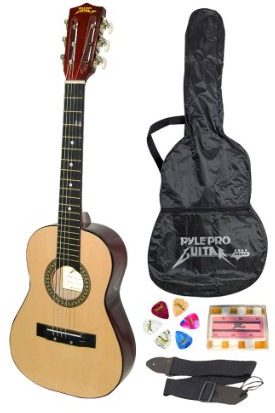 Your son or daughter has shown an interest in playing the guitar, an interest so strong that it now demands your support in the form of lessons, encouragement, or even— a guitar of their own? First of all, rejoice and be proud! Now, what kind of guitar should you buy?
Your son or daughter has shown an interest in playing the guitar, an interest so strong that it now demands your support in the form of lessons, encouragement, or even— a guitar of their own? First of all, rejoice and be proud! Now, what kind of guitar should you buy?
It depends very much on the child. Perhaps they’ve already started playing and have developed distinct preferences in musical genres and the kinds of guitars needed to play them. Or perhaps they simply like the guitar and want to learn how to play.
You’re in luck. These days you not only have choices, but many of the best guitar companies now manufacture instruments specifically for beginners and schools at prices lower than what you’d pay for a new smartphone. These guitars are usually made of cheaper materials; not a lot is invested in them as the first guitar is rarely the one that one that launches a professional music career, but they are designed to be easier to play.
The Easy Way Vs. The Smart Way
You can save yourself a great deal of time by simply going to your local music store and asking for the most popular brand’s beginner guitar. This may or may not result in a wise purchase, because the companies that make the best pro guitars don’t necessarily make the best beginner versions.
Luckily you can also make a wise consumer decision based on the information we’re about to give you.
A Chance to Bond
It’s important to relax, have fun, and not take the process too seriously. Sure, you want to make the best choice but if you mess up, don’t think you’re ruining your child’s chances of becoming the next Bonnie Raitt.
As the above quotes clearly attest, nothing, not even a bad instrument, can hold back a child when the guitar fever overtakes them! Make the guitar search a fun, happy exercise in bonding for you and your child, and you can’t go wrong.
A Different Kind of Beginner
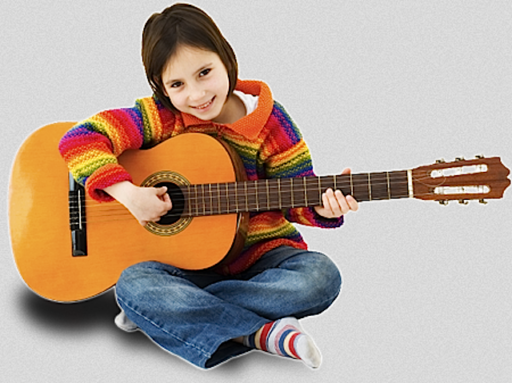 It’s easy to find information about buying a first guitar. The rules applying to adult beginners are also quite true for child beginners, except for one small detail: A child is a different kind of beginner.
It’s easy to find information about buying a first guitar. The rules applying to adult beginners are also quite true for child beginners, except for one small detail: A child is a different kind of beginner.
For one thing, children are smaller. Their arms are shorter and their fingers don’t reach as far.
They’re also a little more sensitive to pain, so the prerogative to suffer until callouses grow on the fingertips is a little hard to enforce. A parent or teacher is likely to encounter resistance, either in the child’s refusal to play or in their own reluctance to oblige a wee person to endure pain.
Thus when buying for children it’s paramount to consider the guitar’s size, weight, action (how far the strings rise above the fretboard), and the sharpness of the strings.
Learning Through Play and Imagination
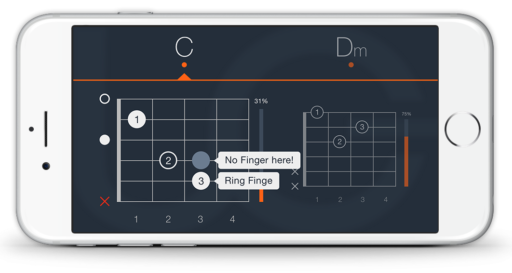
Another thing to consider, and perhaps just as significant, is the fact that the child’s mind is still developing, learning, according to Piaget, mostly from play— that is, from doing things that occupy their attention and are simply fun. The Uberchord app is thus a great practice and learning aid for growing minds because it demands a child’s attention while being fun to use!
We’ve seen that even very young children are capable of becoming masters of complex intellectual tasks like mathematics, computer programming, or learning an instrument, but even the boy Mozart would become distracted from playing his brilliant compositions when his cat came into the room, and it was hard to get him back to focusing on the keys.
Also, check out Monster Chords, a great app for kids to learn guitar at home.
Respect the Mental Picture
If playing the guitar is your child’s idea, she probably has a picture in her mind of herself playing a specific kind of music on a certain kind of guitar in a certain kind of way, and if you surprise her with one that’s markedly different from her fantasy she may be disappointed and abandon the dream.
This mental picture is seldom fixed, and your child may change her mind in the course of the search, but it’s still a good idea to involve your child in the selection process, keeping the lines of communication open and being aware of the importance of play and imagination in her development as a musician.
About Price
The question of how much to spend is highly individual. Don’t worry too much about wasting money now; if your child decides after a month that they no longer wish to play guitar you can either keep the instrument until they have a change of heart, or sell it, or use it as a portable travelling guitar if you play guitar yourself.
I think most parents would agree that it’s wasteful to purchase a top quality guitar for a child, since the first guitar’s purpose is to teach. However, if you are going to the trouble of buying a guitar to help your child learn, you want to buy a guitar that will be easy to play and visually appealing to your child.
All said, your budget for a new beginner’s guitar should probably run between $50.00 and $150.00 USD (between 46 and 140 euros).
The Secondhand Solution
Secondhand guitars are an option as well, but because they tend not to depreciate in value with time, it’s sometimes hard to save any money by going secondhand, and new guitars usually come with a warranty. If you’re lucky enough to find a secondhand guitar that fits the criteria we’ve listed here and is less than $50 USD (46 EURO), grab it!
The First Guitar Won’t Be the Last!
Be sure to mention from the beginning that this first guitar will be set aside for a better one once the child has progressed sufficiently. Depending on how old your child will be once they’ve outgrown their first guitar, the second guitar is likely to be their decision and their purchase.
It really does give adolescents a sense of pride and independence when they can take over this transition for themselves. The guitar is still a rebel instrument after all, so being too paternal can make your child see guitar playing as your choice, not his. And the more the child is personally invested in a guitar the more likely he is to persevere with learning it.
When you and your child are ready to go ahead and buy that first guitar, you’ll need to be prepared, especially if you don’t play guitar yourself. And that’s what we’re here to help you do. We’ll start by presenting the three main guitar categories.
The Classical
The classical guitar comes with nylon strings, has no pick guard (because you don’t use a pick), is lightweight, and has a wooden neck minus the steel rod that comes with other types of guitars. It’s usually a nice-looking thing in itself, used specifically for classical guitar music, Latin genres, and some folk music. The Hohner HC03 3/4-Size Classical Acoustic Guitar is a wonderful example of a reasonably priced ($110-$150 or 100-140 EUR) instrument with the quality necessary to ease learning.
A Few More Classical Guitars We Recommend in the $50-$150 USD (46-140 EURO) Range
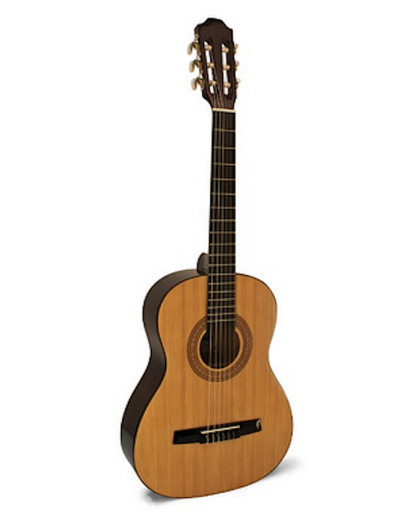
Pluses
The classical guitar is the easiest on little fingers because of its nylon strings. A quality guitar with good action will still necessitate the growing of callouses on the fingertips, but this won’t be quite so painful as with other guitars. The sound isn’t loud enough to annoy neighbors or napping family members, and the tone is quite pleasant. Many reputable companies makes smaller sizes and even produce beginner guitars at very reasonable prices. If your child simply wants to learn for now and later decide what kind of music he or she wants to play, this would be your best bet. And of course if your child wants to learn classical or Latin genres, the classical guitar is a must.
Minuses
The classical guitar is limited in the musical genres it can play. Your little Jimi Hendrix might find its sound and look to be very different from what he imagined, and your little Lenni Stern might yearn for a guitar with a little more soul. Another drawback is that sometimes the necks are a bit wide for little hands to get around, even if this does mean that the strings are further apart and thus easier to chord.
The Acoustic
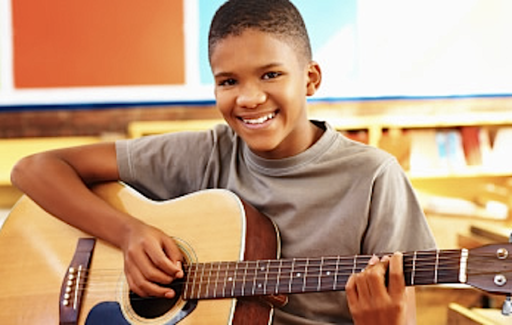
What we call the acoustic guitar is similar to the classical except that it has steel strings, a steel rod in the neck, usually a pick guard, and sometimes the option of going electric with the aid of a pickup (although most guitarists agree that an acoustic guitar sounds best amplified with a microphone). As an example, the good folks at Yamaha have managed to produce a great beginner guitar for kids with their Yamaha FG JR1 3/4 size acoustic guitar.
A Few More Acoustic Guitars We Recommend in the $50-$150 USD (46-140 EURO) Range
Pluses
The acoustic is the most versatile of guitars. For all but serious classical or jazz pieces or rock guitar solos the acoustic is able to play rhythm, fingerpick, flatpick, and strum in folk, blues, jazz, country, rock, bluegrass, and many other genres. It’s also a great accompaniment to the human voice (singer/songwriters love ’em).
Minuses
The acoustic is a little heavier than the classical (although many manufacturers have overcome this for kids guitars) and the steel strings are more painful to play, at least at first
The Electric
The electric guitar is a solid slab of wood with a steel-reinforced neck. The strings are steel, like the acoustic. But unlike the acoustic the electric guitar is hard to hear without electic amplification, which means you have to buy an amp (10 watts is strong enough for a child’s learning needs) and a cable to hook it to your guitar.
Recently the Squier by Fender MINI strat electric guitar has been getting rave reviews and can be had for the very reasonable price of $115-$130 (105-120 EUR) depending on which accessories are included.
A Few More Electric Guitars We Recommend in the $50-$150 USD (46-140 EURO) Range
Pluses
If your child fell in love with guitar as a result of watching rock stars on television or in case he or she thinks of guitar music as synonymous with shredding, they’re not going to be happy— or stay motivated— with anything but an electric axe. Also the action is usually good on electric guitars, placing less strain on little fingers.
Minuses
Controlling the volume so as not to disturb family members, annoy the neighbors, or hurt the child’s delicate eardums can be a bit of a hassle. Also the guitar can be a bit heavy for a young child to wear.
Another difficulty is that all the knobs on the guitar are highly attractive and distracting to smaller children. If your child is still distractible, perhaps the electric guitar purchase can wait.
Rules of Thumb
When buying a guitar for your child, keep the following things in mind:
- Action. How high are the strings from the fretboard? Too low and they’ll have an annoying buzz. Too high and they’ll be very difficult to hold down.
- Tuning. Is the guitar easy to tune? Does it stay in tune or does it constantly have to be retuned? If there are smaller children in the house rest assured that they’ll try to turn the tuning pegs at every opportunity. Make sure they can be retuned quickly.
- Size. Is the guitar a comfortable size and weight for your child? If the guitar is hard to hold and play, lessons will be an exercise in futility and frustration. If it’s too small the child will have a hard time later transitioning to a normal-sized guitar. Children whose height is between 3’10” amd 4’5″ can use a 30″ guitar, which is a quarter of the standard size. A three quarter guitar size (34″) is good for children who stand between 4’6″ and 4’11”, and children of 5′ and higher can play a standard size (40″) guitar. (Kid Guitarist).
- Brand Names. Not all top guitar brands manufacture a good beginner guitar, and some of the best beginner guitars are made by brands that aren’t famous for professional quality guitars. So keep the criteria in mind and don’t be dazzled by the name between the tuning pegs.
- South Paws. If your child is left handed don’t bother looking for a left handed guitar. The demands placed on both hands in guitar playing are roughly equal, on average, and part of learning guitar is developing the capabilities of both hands.
 String Change. Be sure to tell your child to never take all the strings off the guitar. When changing strings, only remove one at a time and replace, as the guitar’s neck depends on the string tension for some support, and repeatedly removing all strings (especially leaving them off) can warp the guitar. Also remember that when new strings go on they can take a while to adjust to the guitar, making it hard to tune at first. If you replace the strings, let them stay on the guitar for a day or two before tuning for better results.
String Change. Be sure to tell your child to never take all the strings off the guitar. When changing strings, only remove one at a time and replace, as the guitar’s neck depends on the string tension for some support, and repeatedly removing all strings (especially leaving them off) can warp the guitar. Also remember that when new strings go on they can take a while to adjust to the guitar, making it hard to tune at first. If you replace the strings, let them stay on the guitar for a day or two before tuning for better results.- Tuning up. Strings stay tuned better if you turn up to the note you want instead of down to it. If the note is too high, tune it to below where you want it to be and then up again.
- Uberchord. The sooner your child starts using the Uberchord app (click for free download) the sooner he or she can start adding another dimension of fun to guitar practice, benefiting from our app’s power to accelerate improvement!
Accessories and Set-up
Ideally your child’s guitar will arrive with all they need to get started right away, which should at least include extra strings, a tuner, a strap, and a carrying case, and for electric guitars should also include a small amp and cable and possibly headphones for quiet practicing.
It’s also important to have someone present— a friend, family member, or guitar teacher— who can get your child started with the new guitar if they haven’t already been taking lessons. Sometimes this first-time mentor is all they need, getting them off to a good start with enough motivation to keep them going until they achieve mastery.
Happy shopping, and may the instrument you find afford your child many happy hours!
Thanks so much for visiting our blog here at Uberchord! We hope you’ll stick around and browse our articles as there are several topics that can help your child progress fast and succeed at learning the guitar. Some of these articles include guitar assistant guitar tuner, the guitar g sharp chord, and don’t let the sun go down on me guitar chords.


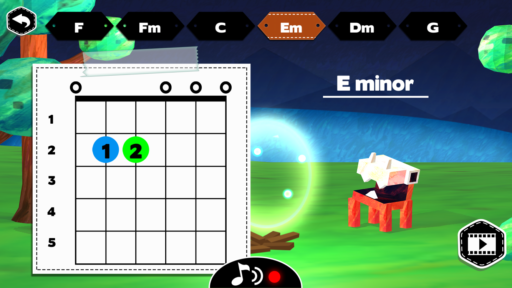
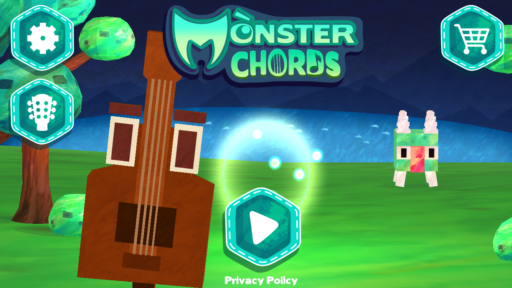
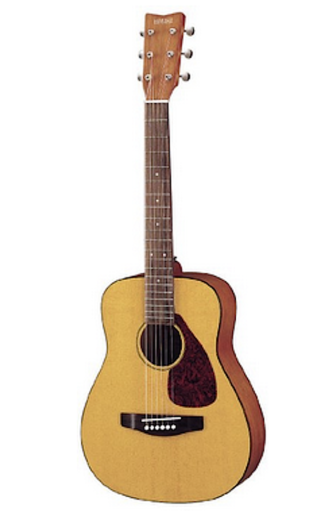
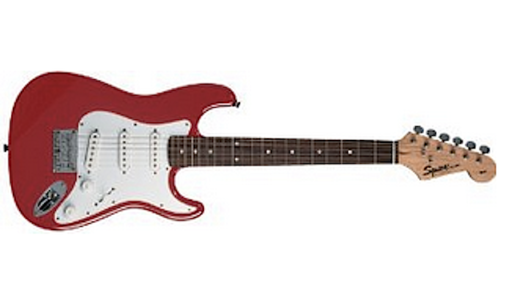
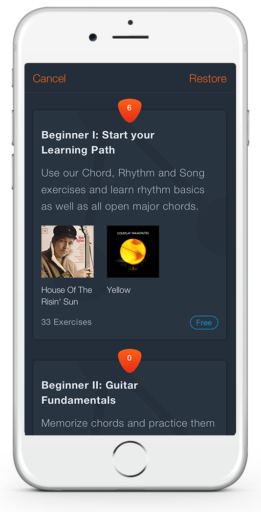


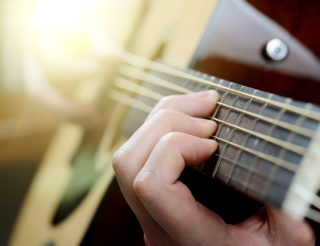



Wow, cool post. I’d like to write like this too – taking time and real hard work to make a great article… but I put things off too much and never seem to get started. Thanks though.